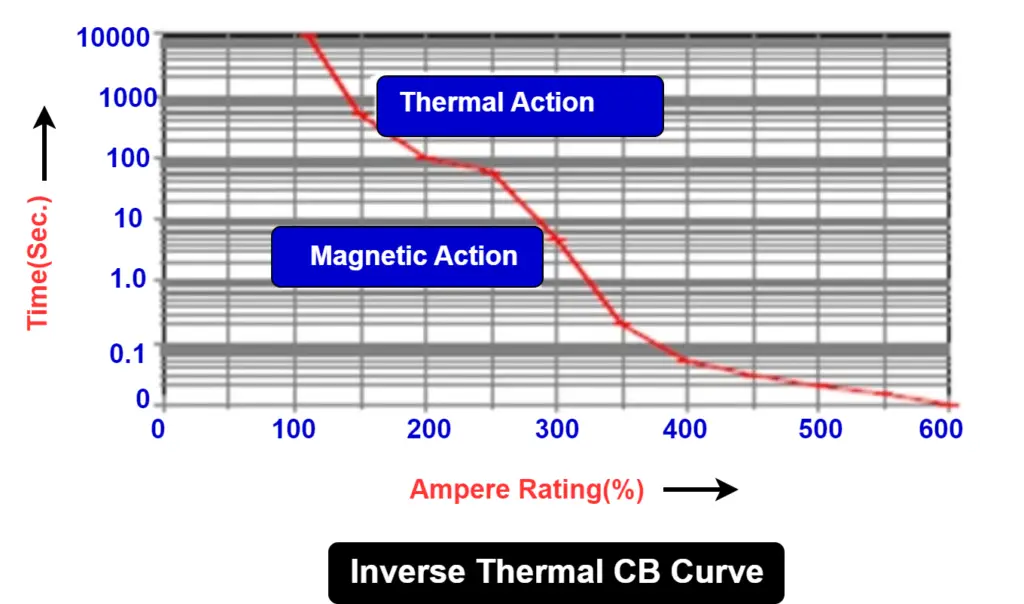Inverse time circuit breaker and Instantaneous trip circuit breaker are used to protect the equipment in the case of overload and short-circuit electrical faults. The short circuit fault comprises a 2-Phase short circuit(L-L), 3-Phase short circuit (L-L-L), any line-to-ground (L-G) fault, and 3-phase line-to-ground (L-L-L-G) fault.
It is important to note that there are different types of circuit breakers, each with its purpose, characteristics, and applications. In this article, we discuss the following two types of circuit breakers.
- Inverse time circuit breaker
- Instantaneous trip circuit breaker
Both types of circuit breakers serve different purposes in electrical systems. Their selection is based on the specific requirements of the application. They are also known as thermal-magnetic circuit breakers. In many modern circuit breakers, both inverse time and instantaneous trip features can be combined to provide an overall level of protection against a wide range of overcurrent conditions.
Inverse Time Circuit Breakers
Inverse time circuit breakers have both thermal and instantaneous trip features and trips when overload or short circuit condition occurs.
Inverse time circuit breakers are inverse time trip circuit breakers or inverse time overcurrent circuit breakers. The higher the current or shorter the overload duration, the faster the circuit breaker trip, which is the inverse trip characteristic associated with it. They are a type of electrical protection device used in power distribution systems.
The main function is to prevent damage to electrical equipment and circuits from overcurrent conditions. These circuit breakers are designed to trip or open the circuit when the current flowing through it exceeds a certain threshold over a specified period.

The thermal element of the breaker senses the heat and trips the breaker after a delay if the current exceeds the set current. In the case of a short circuit, the breaker’s magnetic action senses the instantaneous value of current and trips the breaker.

The inverse time circuit breakers are to be sized to a maximum of 250% of the motor FLA as per the guidelines of the National Electrical Code.
Construction of Inverse Time Circuit Breaker
An inverse time circuit breaker typically consists of the following components.
A Current sensor –may be a shunt resistor for lower-current applications or a CT (Current transformer) in high-current applications.
Trip mechanism – Includes a bimetallic strip that operates based on the current magnitude.
Time delay mechanism –Includes springs, dashpots, and other components.
Adjustment mechanism – allows adjusting the trip current and time delay settings to meet the requirement of the protected circuit.
Inverse time circuit breakers operate based on thermal principles. They are commonly used in many applications, from typical residential to heavy industrial motor loads. They are often used to protect circuits from overload conditions, short circuits, and other types of overcurrent situations that can lead to electrical fires or damage to equipment.
Inverse time circuit breakers are designed to provide a time-delayed response to overcurrent conditions. The time delay is inversely proportional to the overcurrent magnitude. In other words, a higher overcurrent will cause the circuit breaker to trip faster, while a lower overcurrent will result in a longer time delay before tripping.
Applications of Inverse Time Circuit Breaker
This type of circuit breaker is commonly used to protect against overload conditions, where the current exceeds the rated capacity of the circuit but not by a large margin. Inverse time circuit breakers allow temporary overcurrent during start-up or routine operation, But they will trip if the overcurrent persists for an extended period, including a potential fault.
Instantaneous Trip Circuit Breakers
The primary function of an instantaneous trip circuit breaker is to provide rapid and reliable protection against short circuits and other high-current faults that could lead to equipment damage, fire, or electrical hazards. Instantaneous trip circuit breakers protect the electrical network from a short circuit, ground fault, or locked rotor current (Motor and generator protection).

Instantaneous trip circuit breakers – as the name indicates, provide no intentional time delay. They are designed to trip almost immediately when an overcurrent or short circuit condition is detected. These circuit breakers protect against severe faults that could cause extensive damage or danger to personnel.
It will trip magnetically in response to the short circuit current and doesn’t have a thermal function. They are also called magnetic-only circuit breakers or magnetic circuit breakers because their operation is based solely on magnetic trip mechanisms. Modern circuit breakers often combine thermal and magnetic trip mechanisms to protect against overcurrent and short-circuit conditions.
These breakers use magnetic and electronic components to sense the current passing through the circuit. Circuit breakers open rapidly when the current exceeds a pre-set threshold.
The Instantaneous trip circuit breakers are to be sized to a maximum of 250% of the motor FLA as per the guidelines of the National Electrical Code.
Construction of Instantaneous Trip Circuit Breaker
An instantaneous circuit breaker consists of some essential components and mechanisms.
Bimetallic strip – consists of two metals that cause the strip to bend or warp as it heats up.
Mechanical linkage – is linked to the breaker’s contacts.
Arc chute – extinguish the arc and prevent damage to the contacts.
Magnetic release mechanism (optional) – provides fast and reliable circuit interruption.
It is worth noting that the specific design and features of instantaneous trip circuit breakers can vary based on the manufacturer and the intended application. Some may include adjustable settings for the trip current threshold, allowing for customization to match the requirements of the specific circuit being protected.
Applications
Instantaneous trip circuit breakers are often employed in critical systems where rapid tripping is necessary to prevent catastrophic consequences. For example, they provide a quick and reliable response to systems where faults could lead to fire, explosions, or other safety hazards.
Instantaneous trip circuit breakers are often used in applications where the protection of critical equipment and personnel safety is of utmost importance. Example of such applications includes industrial machinery, power distribution systems, control panels, and other areas where rapid fault protection is essential.